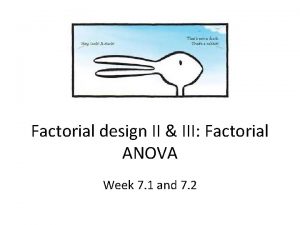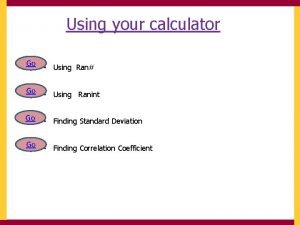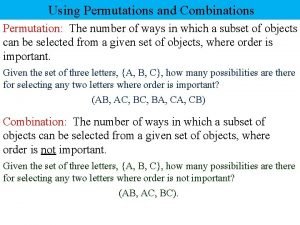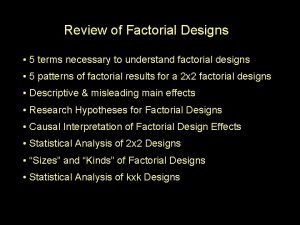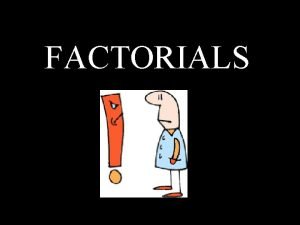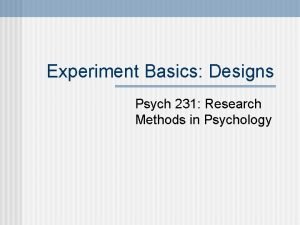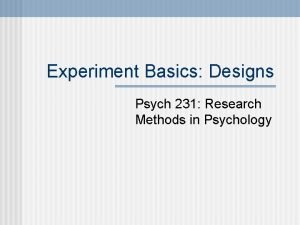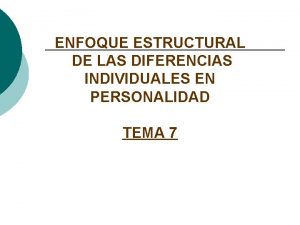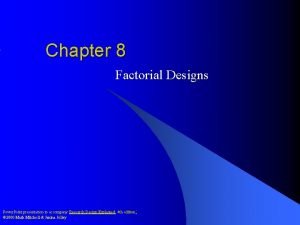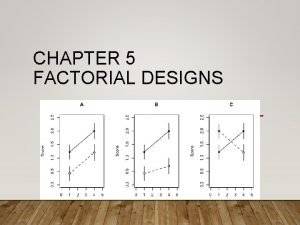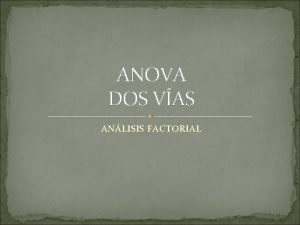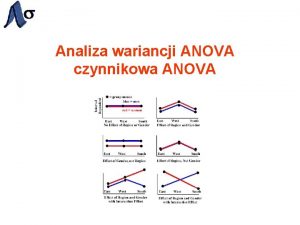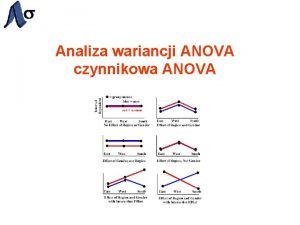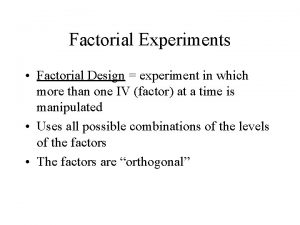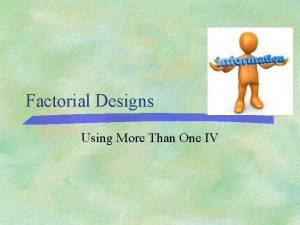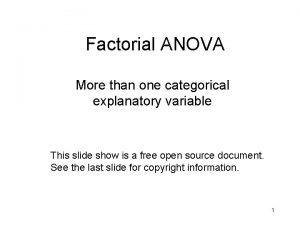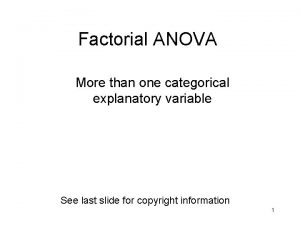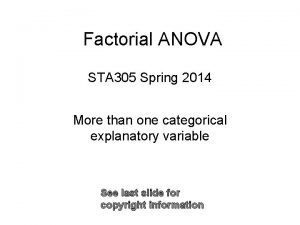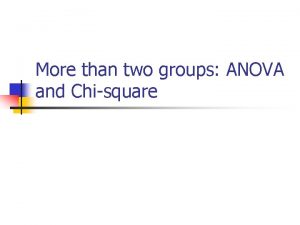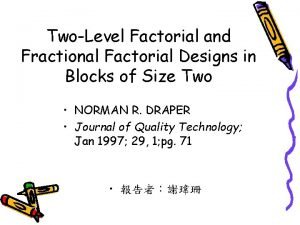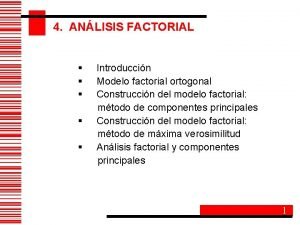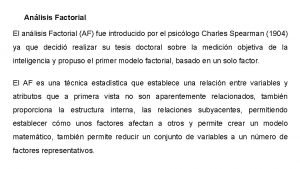Factorial ANOVA 2 or More IVs Questions 1







































- Slides: 39

Factorial ANOVA 2 or More IVs

Questions (1) v What are main effects in ANOVA? v What are interactions in ANOVA? How do you know you have an interaction? v What does it mean for a design to be completely crossed? Balanced? Orthogonal? v Describe each term in a linear model like this one:

Questions (2) v Correctly interpret ANOVA summary tables. Identify mistakes in such tables. What’s the matter with this one? Source SS A 512 Df 2 (J-1) MS 128 F 128 B 108 1 (K-1) 108 54 Ax. B 96 2 (J-1)(K-1) 48 24 Error 12 5 N-JK 2

Questions (3) v Find correct critical values of F from a table for a given design. v How does post hoc testing for factorial ANOVA differ from post hoc testing in one -way ANOVA? v Describe a concrete example of a two-factor experiment. Why is it interesting and/or important to consider both factors in one experiment?

2 -way ANOVA • So far, 1 -Way ANOVA, but can have 2 or more IVs aka Factors. • Example: Study aids for exam – IV 1: workbook or not – IV 2: 1 cup of coffee or not Workbook (Factor A) Caffeine (Factor B) No Yes Caffeine only Both No Neither (Control) Workbook only

Main Effects (R & C means) N=30 per cell Caffeine (Factor B) Workbook (Factor A) No Yes Caff =80 SD=5 Control =75 SD=5 77. 5 Both =85 SD=5 Book =80 SD=5 82. 5 No Col Means Row Means 82. 5 77. 5 80

Main Effects and Interactions • Main effects seen by row and column means; Slopes and breaks. • Interactions seen by lack of parallel lines. • Interactions are a main reason to use multiple IVs

Single Main Effect for B (Coffee only)

Single Main Effect for A (Workbook only)

Two Main Effects; Both A & B Both workbook and coffee

Interaction (1) Interactions take many forms; all show lack of parallel lines. Coffee has no effect without the workbook.

Interaction (2) People with workbook do better without coffee; people without workbook do better with coffee.

Interaction (3) Coffee always helps, but it helps more if you use workbook.

Labeling Factorial Designs • Levels – each IV is referred to by its number of levels, e. g. , 2 X 2, 3 X 2, 4 X 3 designs. Two by two factorial ANOVA. • Cell – treatment combination. • Completely Crossed designs –each level of each factor appears at all levels of other factors (vs. nested designs or confounded designs). • Balanced – each cell has same n. • Orthogonal design – random sampling and assignment to balanced cells in completely crossed design.

Review v. What are main effects in ANOVA? v. What are interactions in ANOVA? How do you know you have an interaction? v. What does it mean for a design to be completely crossed? Balanced? Orthogonal?

Population Effects for 2 -way Population main effect associated with the treatment Aj (first factor): Population main effect associated with treatment Bk (second factor): The interaction is defined as , so the linear model is: The interaction is a residual: Each person’s score is a deviation from a cell mean (error). The cell means vary for 3 reasons.

Expected Mean Squares E(MS error) = (Factor A has J levels; factor B has K levels; there are n people per cell. ) E(MS A) = E(MS B) = E(MS Interaction) = Note how all terms estimate error.

F Tests For orthogonal designs, F tests for the main effects and the interaction are simple. For each, find the F ratio by dividing the MS for the effect of interest by MS error. Effect A B Ax. B Interaction F df J-1, N-JK K-1, N-JK (J-1)(K-1), N -JK

Example Factorial Design (1) • Effects of fatigue and alcohol consumption on driving performance. • Fatigue – Rested (8 hrs sleep then awake 4 hrs) – Fatigued (24 hrs no sleep) • Alcohol consumption – None (control) – 2 beers – Blood alcohol. 08 % • DV - performance errors on closed driving course rated by driving instructor.

Cells of the Design Alcohol (Factor A) Orthogonal design; n=2 Fatigue (Factor B) None (J=1) 2 beers (J=2) . 08 % (J=3) Tired (K=1) Cell 1 2, 4 M=3 Cell 2 16, 18 M=17 Cell 3 18, 20 M=19 M=13 Rested (K=2) Cell 4 0, 2 M=1 Cell 5 2, 4 M=3 Cell 6 16, 18 M=17 M=2 M=10 M=18 M=10

Factorial Example Results Main Effects? Interactions? Both main effects and the interaction appear significant. Let’s look.

Data Person DV Cell A alc B rest 1 2 1 1 1 2 4 1 1 1 3 16 2 2 1 4 18 2 2 1 5 18 3 3 1 6 20 3 3 1 7 0 4 1 2 8 2 4 1 2 9 2 5 2 2 10 4 5 2 2 11 16 6 3 2 12 18 6 3 2 Mean 10

Total Sum of Squares Person DV Mean 1 2 10 -8 64 2 4 10 -6 36 3 16 10 6 36 4 18 10 8 64 5 18 10 8 64 6 20 10 10 100 7 0 10 -10 100 8 2 10 -8 64 9 2 10 -8 64 10 -6 36 11 16 10 6 36 12 18 10 8 64 Total D D*D 728

SS Within Cells Person DV Cell 1 2 1 3 1 2 4 1 3 16 2 17 1 4 18 2 17 1 5 18 3 19 1 6 20 3 19 1 7 0 4 1 1 8 2 4 1 1 9 2 5 3 1 10 4 5 3 1 11 16 6 17 1 12 18 6 17 1 Total Mean D*D 12

SS A – Effects of Alcohol Person M Level Mean D*D (A) 1 10 1 2 64 2 10 1 2 64 3 10 2 10 0 4 10 2 10 0 5 10 3 18 64 6 10 3 18 64 7 10 1 2 64 8 10 1 2 64 9 10 2 10 0 10 10 2 10 0 11 10 3 18 64 12 10 3 18 64 Total 512

SS B – Effects of Fatigue Person M Level Mean D*D (B) 1 10 1 13 9 2 10 1 13 9 3 10 1 13 9 4 10 1 13 9 5 10 1 13 9 6 10 1 13 9 7 10 2 7 9 8 10 2 7 9 9 10 2 7 9 10 10 2 7 9 11 10 2 7 9 12 10 2 7 9 Total 108

SS Cells – Total Between Person M Cell 1 10 1 3 49 2 10 1 3 49 3 10 2 17 49 4 10 2 17 49 5 10 3 19 81 6 10 3 19 81 7 10 4 1 81 8 10 4 1 81 9 10 5 3 49 10 10 5 3 49 11 10 6 17 49 12 10 6 17 49 Total Mean D*D (Cell) 716

Summary Table Source SS Total 728 Between 716 A 512 B 108 Within 12 Source A B Ax. B Error SS 512 108 96 12 Check: Total=Within+Between 728 = 716+12 Interaction = Between – (A+B). Interaction = 716 -(512+108) = 96. df 2 (J-1) 1(K-1) 2 (J-1)(K-1) 6 (N-JK) MS 256 108 48 2 F 128 54 24

Interactions Choose the factor with more levels for X, the horizontal axis. Plot the means. Join the means by lines representing the other factor. The size of the interaction SS is proportional to the lack of parallel lines. If interactions exist, the main effects must be qualified for the interactions. Here, effect of alcohol depends on the amount of rest of the participant.

Review v. Correctly interpret ANOVA summary tables. Identify mistakes in such tables. What’s the matter with this one? Source SS A 512 Df 2 (J-1) MS 128 F 128 B 108 1 (K-1) 108 54 Ax. B 96 2 (J-1)(K-1) 48 24 Error 12 5 N-JK 2

Proportions of Variance We can compute R-squared for magnitude of effect, but it’s biased, so the convention is to use omega-squared.

Planned Comparisons Cell 1 A 1 B 1 2 A 2 B 1 3 A 3 B 1 4 A 1 B 2 5 A 2 B 2 6 A 3 B 2 Mean 3 17 19 1 3 17 C 1 -1/3 1/3 -6 C 2 1/2 -1/4 -12 B 1 v B 2 No alc v others

Planned Comparisons (2) The first comparison (B 1 v B 2) has a value of – 6. For any comparison, Note this is the same as SS for B in the ANOVA. (critical t has dfe) Note 7. 348 squared is 54, which is our value of F from the ANOVA.

Planned Comparisons (3) We can substitute planned comparisons for tests of main effects; they are equivalent (if you choose the relevant means). We can also do the same for interactions. In general, there a total of (Cells-1) independent comparisons we can make (6 -1 or 5 in our example). Our second test compared no alcohol to all other conditions. This looks to be the largest comparison with these data.

Post Hoc Tests For post hoc tests about levels of a factor, we pool cells. The only real difference for Tukey HSD and Newman – Keuls is accounting for this difference. For interactions, we are back to comparing cells. Don’t test unless F for the effect is significant. For comparing cells in the presence of an interaction:

Post Hoc (2) In our example A has 3 levels, B has 2. Both were significant. No post hoc for B (2 levels). For A, the column means were 2, 10, and 18. Are they different? A: Yes, all are different because the differences are larger than 3. 07. But because of the interaction, the interpretation of differences in A or B are tricky.

Post Hoc (3) For the rested folks, is the difference between no alcohol and 2 beers significant for driving errors? The means are 1 and 3. A: They are not significantly different because 2 is less than 5. 63. Note: data are fictitious. Do not drink and drive.

Review • Describe each term in a linear model like this one: v How does post hoc testing for factorial ANOVA differ from post hoc testing in oneway ANOVA? v Describe a concrete example of a two-factor experiment. Why is it interesting and/or important to consider both factors in one experiment?

Higher Order Factorials • If you can do ANOVA with 2 factors, you can do it with as many as you like. • For 3 factors, you have one 3 -way interaction and three 2 -way interactions. • Computations are simple but tedious. • For orthogonal, between-subject designs, all F tests have same denominator. • We generally don’t do designs with more than 3 factors. Complex & expensive.
 More more more i want more more more more we praise you
More more more i want more more more more we praise you More more more i want more more more more we praise you
More more more i want more more more more we praise you Factorial anova
Factorial anova Factorial anova
Factorial anova Ivs vs nature
Ivs vs nature International valuation standards council
International valuation standards council Hdvr.ivs
Hdvr.ivs Ivs benešov
Ivs benešov Beda one way anova dan two way anova
Beda one way anova dan two way anova One way anova vs two way anova
One way anova vs two way anova Anova two way adalah
Anova two way adalah 5 apples in a basket riddle
5 apples in a basket riddle The more you study the more you learn
The more you study the more you learn Aspire not to have more but to be more
Aspire not to have more but to be more Newton 1st law
Newton 1st law Knowing more remembering more
Knowing more remembering more The more i give to thee the more i have
The more i give to thee the more i have More choices more chances
More choices more chances Human history becomes more and more a race
Human history becomes more and more a race Ran# calculator
Ran# calculator Permutation and combination
Permutation and combination Factorial design
Factorial design Main effects statistics
Main effects statistics Within subject design vs between subject design
Within subject design vs between subject design Descomposición factorial
Descomposición factorial Permutation formula
Permutation formula 1000 factorial
1000 factorial Factorial haskell
Factorial haskell Factorial of 27
Factorial of 27 Definition of factorial
Definition of factorial Within-subject design example
Within-subject design example 11factorial
11factorial Within subjects design
Within subjects design Iv and dv in research
Iv and dv in research Modelos factoriales lexicos de la personalidad
Modelos factoriales lexicos de la personalidad Full factorial design
Full factorial design Desain faktorial 2 pangkat 3
Desain faktorial 2 pangkat 3 8 factorial
8 factorial 5 factorial
5 factorial Int factorial(int n)
Int factorial(int n)



